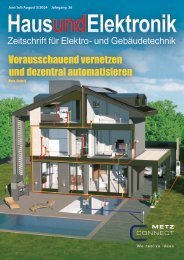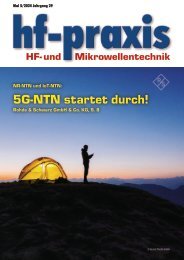5-2019
Fachzeitschrift für Hochfrequenz- und Mikrowellentechnik
Fachzeitschrift für Hochfrequenz- und Mikrowellentechnik
Sie wollen auch ein ePaper? Erhöhen Sie die Reichweite Ihrer Titel.
YUMPU macht aus Druck-PDFs automatisch weboptimierte ePaper, die Google liebt.
RF & Wireless<br />
Figure 10: Antennas used for this example: a) standard UWB dipole, b) UWB edge-fed dipole, c) UWB coplanar<br />
monopole, d) planar Yagi with variable-width strips<br />
Figure 11: SpecSheet run in progress.<br />
nature and fairly small. By not<br />
having a gain specification, the<br />
antenna will run a bit faster. If<br />
this assumption turned out to be<br />
incorrect, or if some other error<br />
were made to the SpecSheet,<br />
the user would simply need to<br />
duplicate the specification from<br />
the right-click menu, add a gain<br />
spec, and re-run the antenna.<br />
With the directional case there<br />
are some gain requirements built<br />
into the SpecSheet (Figure 8).<br />
None of the polarization or other<br />
advanced features for gain specification<br />
are being used in this<br />
example and the gain is actually<br />
specified for the downward<br />
direction, this is explained in the<br />
results section.<br />
One of the key areas is the shape<br />
or overall limit on the form factor.<br />
To make these antennas easy<br />
to construct, they were all limited<br />
to 8” (203 mm) in width and<br />
10.5” (267 mm) in height, with<br />
a planar form factor (Figure 9).<br />
This limit was chosen because<br />
the design was printed to a standard<br />
U.S. letter size piece of<br />
paper to be used as a template to<br />
cut out the antenna on a singlesided<br />
foil-clad board.<br />
the synthesis/optimizer, and if<br />
the user does not select any, the<br />
AntSyn tool will select antennas<br />
automatically based on what<br />
could work with the given specifications.<br />
In this example, four<br />
different types of antennas were<br />
selected: three versions of a planar<br />
ultra-wideband (UWB) omni<br />
antenna and a directional Yagi<br />
antenna (Figure 10).<br />
These antennas are described<br />
in more detail in the Results<br />
section.<br />
Running AntSyn<br />
Software<br />
Once the specs have been added<br />
as desired, the quality level<br />
and run are set. For this example,<br />
omni antennas run best<br />
at medium quality and should<br />
finish in less than five minutes.<br />
Directional antennas take much<br />
longer to run (low quality about<br />
15 minutes, medium quality<br />
about 40 minutes, high quality<br />
3 to 4.5 hours). Medium quality<br />
has been selected here because<br />
it only takes 1 to 10 minutes<br />
to complete. If it is desired to<br />
see the progress of a run while<br />
it is ongoing, keep clicking on<br />
the antenna name and the latest<br />
results will be shown (Figure 11).<br />
Results<br />
The results for the standard<br />
UWB omnidirectional antenna,<br />
which has a pattern that looks<br />
omnidirectional across the entire<br />
frequency range, are shown in<br />
Figure 12. This antenna would<br />
be used if the antenna is near<br />
strong TV stations and forward<br />
gain is not needed to pick up<br />
the signals. Figure 13 shows an<br />
antenna that is fed on its edge,<br />
which has the interesting characteristic<br />
of not requiring the<br />
Selecting Antenna<br />
Types<br />
There are 240 antenna types currently<br />
available in the AntSyn<br />
library as a starting point for<br />
Figure 12: Standard UWB dipole results<br />
hf-praxis 5/<strong>2019</strong> 73
















